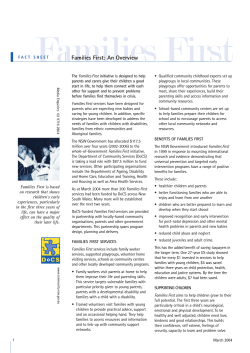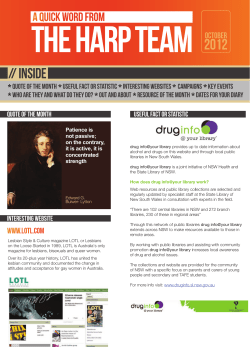
DON’T SPREAD AQUATIC PESTS Watch out for the invasive sea squirt,
w w w. i n d u s t r y. n s w. g ov. a u / i n fo / s e a s q u i r t DON’T SPREAD AQUATIC PESTS Watch out for the invasive sea squirt, Didemnum vexillum Didemnum vexillum is a type of sea squirt or ascidian that can grow rapidly, and has the potential to smother both artificial structures and natural habitats. This pest is of national concern due to its invasive characteristics, and known impacts overseas. It has not previously been detected in NSW or elsewhere in Australia. Identification This sea squirt is difficult to identify and may be confused with native species of sea squirt. Its features include: • • • • Distinctive mustard or orange/yellow colour. Spongy texture, can feel leathery but not slimy. Can look like yellow wax dripping from artificial structures. Surface has dark leaf-like veins with small pores. Photos courtesy Aquenal Pty Ltd If you think you have seen this sea squirt – Report it! Call the I&I NSW 24-hour aquatic pest hotline 02 4916 3877 or email aquatic.pests@industry.nsw.gov.au DON’T SPREAD AQUATIC PESTS – Watch out for the invasive sea squirt, Didemnum vexillum Help stop the spread Prevent the spread of this pest • Keep a look out for sea squirts - report new infestations. • Inspect your boating, fishing and diving gear for unusual plants or animals . • Wash your gear on land away from any water body before visiting another marine location. • Don’t disturb suspicious sea squirts and don’t return any sea quirts or fragments of them to the water. • Abide by any current movement controls (see website for up-to-date information). Distribution and habitat Didemnum vexillum has been reported in New Zealand, northern Europe, USA, Canada and Japan. Industry & Investment NSW (I&I NSW) is currently investigating a suspected outbreak in Twofold Bay on the NSW South Coast. It typically grows on hard surfaces in sub-tidal waters and seems to have a preference for artificial structures such as piers, wharfs, pilings, buoys, channel markers and boat hulls and may also be found on breakwalls and natural reefs. Impacts Boating / shipping • Ensure you inspect your vessel for pests prior to leaving Twofold Bay. • Use freshwater to clean your boat, hull, trailer and any gear on land and away from any water body and dispose of all material collected in a rubbish bin. Don’t wash debris down drains. • Check your moorings, anchor, chain and ropes for any sea squirt fragments and dispose of any fragments in a rubbish bin. • Apply antifouling treatments, if appropriate, on the hull to reduce fouling and the spread of this pest. • Flush internal seawater systems regularly with freshwater or an approved treatment. • Dispose of sewage and bilge water at an approved pump-out facility. • Discharge ballast according to Australian Ballast Water Management Requirements, which recommends discharging as far as possible away from any land mass, and in water at least 200 m deep (see www.aqis.gov.au for further information). Divers The sea squirt has the potential to quickly foul boat hulls (requiring frequent dry dock cleaning and treatment), artificial structures (piers, wharfs, breakwalls and moorings) and has the potential to smother natural reefs and areas of shellfish aquaculture. Where did it come from? It is not known how the suspected sea squirt arrived in NSW. Outbreaks of this sea squirt have previously been recorded in New Zealand and the United States, and it is thought that overseas travel by ships and yachts may have been responsible for those incursions. What is being done? I&I NSW is currently developing a management and eradication plan for this species, including potential control and eradication options. • While diving, watch out for any suspicious growths on hard surfaces, in particular artificial structures such as piers, channel markers, mooring lines and boat hulls. • Don’t disturb suspicious sea squirts as small pieces can break off and form new colonies. • Check your gear for any sea squirt fragments and wash thoroughly in freshwater, ensuring any debris does not re-enter the waterway. Fishers • Check your anchor, chain and ropes for any fragments of the sea squirt. • Dispose of any sea squirt fragments in a rubbish bin. Don’t disturb suspicious sea squirts and don’t return any sea quirts or fragments of them to the water. • Before going to a new location, wash down your trailer, boat and fishing equipment with freshwater away from any water bodies. If you think you have seen this sea squirt – Report it! If you think you’ve seen Didemnum vexillum take a good note of its location (GPS points if possible), take photos (showing the full colony, plus close ups showing fine detail) and report it immediately! Call the I&I NSW 24-hour aquatic pest hotline 02 4916 3877 or email aquatic.pests@industry.nsw.gov.au For further information See www.industry.nsw.gov.au/info/seasquirt or email aquatic.pests@industry.nsw.gov.au 9945 March 2010
© Copyright 2025














